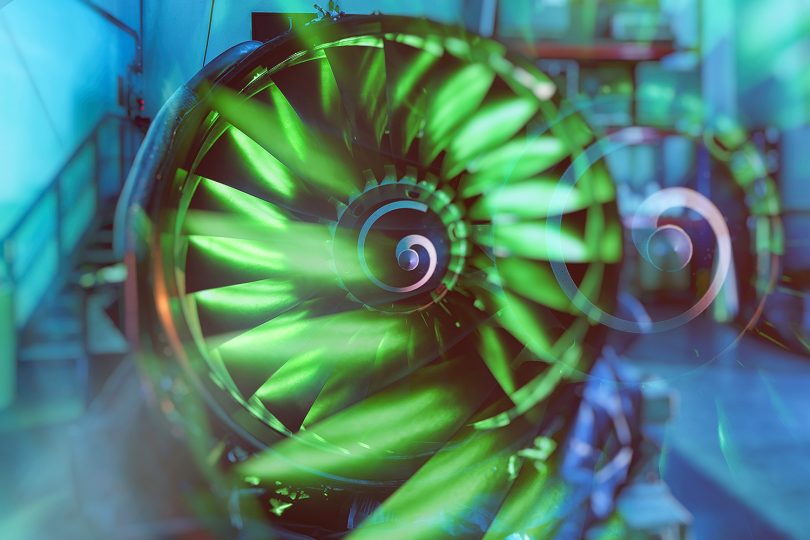Scaled medium-haul aircraft takes off successfully Aviation Cluster of Excellence SE²A demonstrates passenger aircraft model under real conditions
In Peine, near Braunschweig, scientists were able to demonstrate the first full-scale aircraft model from Technische Universität Braunschweig. Another special feature is that the model combines various technologies to reduce energy consumption and emissions. For the first time, this configuration – such as forward swept wings – has been tested in combination with other aircraft components. Since 2019, the research project “SE²A – Sustainable and Energy Efficient Aviation” at Technische Universität Braunschweig has been investigating the future of air transport and how it can be made more efficient. As part of the CLIME project, a full-scale flight model of the SE2A medium-haul aircraft configuration was developed and manufactured in fibre composite construction.
“This is our research vehicle for investigating future technologies for medium-haul aircraft with sustainable propulsion systems and radical energy savings in a real environment – outside the laboratory and wind tunnel,” says Professor Jens Friedrichs, spokesperson for the SE²A cluster. The model has a modular design so that the wings and engines can be replaced. “This modular structure enables many new experiments that we are planning in collaboration with several SE²A scientists. For example, aerodynamics can plan and implement a modular wing together with colleagues from flight control and instrumentation. This will allow us to experimentally demonstrate the basic principles that have been established in theory and numerics. The model not only makes the research activities of the Cluster of Excellence on sustainable aviation visible at an early stage, but also secures them at an early stage, as previous results must already flow together and fit together at the system level.
Forward-swept wings and overwing arrangement of the engines
In mid-June 2024, the model took off with an electric ducted fan propulsion system, a wingspan of three metres and a take-off weight of 18 kilograms. CLIME focuses on the study of flight dynamics and engine integration in a novel configuration. This is characterised by the forward swept wings, the arrangement of the engines above and behind the wing surface, and the additional engine at the rear.
More sustainable flying is achieved, for example, by using less fuel. Fuel can be saved by reducing drag. “One promising mechanism for reducing drag is the boundary layer ingestion effect, or BLI. Drag is primarily generated by the flow around the aircraft surfaces and the formation of a boundary layer. With the rear propulsion system, we succeed in sucking up the boundary layer and filling a momentum deficit in the wake,” explains Dr Christoph Bode from the Institute of Aircraft Propulsion and Turbomachinery at the Technical University of Braunschweig. The engine suction units arranged above the wings in turn extract boundary layers from the wings. “However, this arrangement of the engines causes the aircraft’s centre of gravity to become unbalanced. This is compensated by the forward sweep of the wings.
Successful test flights
The flights on 20 and 26 June were the first six flights of the flight demonstrator. First, the centre of gravity, rudder deflections, trim and flight characteristics were tested throughout the flight envelope. “Testing of the basic vehicle has shown that the forward swept wing design works and that it flies well. The predictions of the flight mechanics have been fulfilled. As planned, we have installed significantly more propulsion power. This means more safety during critical manoeuvres and allows a payload of three to four kilograms for further integration of flight experiments,” says Prof. Jens Friedrichs.
Dr Lutz Bretschneider from the Institute of Flight Guidance: “In the next step, the aircraft will be equipped with additional measurement technology to precisely quantify the flight characteristics and compare them with the calculated values. In addition, pressure sensors will be installed at the rear of the aircraft to measure the suction effect of the fuselage engine. The results can then be compared with data from the other SE²A research projects. The aircraft can and should be used as a test vehicle to investigate, for example, adaptive wings to achieve active wing load reduction and further reduce structural mass, thereby reducing emissions and energy consumption”.
On the importance of scale models in research
“We are convinced that, in addition to basic research, applied aeronautics research is necessary to create an “innovation pipeline” from basic research to application. That is why we have been conducting flight experiments with our own research aircraft since the 1980s. Today, we test new aviation technologies in our latest research aircraft, the Cessna 406, which is of course complex and expensive. The scaled flight test is, so to speak, a game changer,” says Prof. Dr. Peter Hecker, Vice-President for Research at TU Braunschweig.
Thanks to the continuing miniaturisation of avionics and instrumentation, and the increasing availability of model components combined with the latest manufacturing technologies for aircraft structures, aeronautical research can now be conducted using “model aircraft”. “By using scaled experiments, which we are developing together with TU Delft as a strategic partner in aviation research, we can close the gap in the experimental evaluation of research results between the wind tunnel and flight tests. This makes us one of the few European research organisations to have successfully embarked on this path”.
The SE²A Cluster of Excellence at TU Braunschweig
The cluster brings together around 140 scientists from the fields of aeronautics, electrical engineering, energy research and design. Their goals are to drastically reduce energy consumption and emissions from aircraft, reduce noise pollution, develop tailor-made air traffic management and conduct a holistic assessment of resource consumption and climate impact.
TU Braunschweig works closely with aviation experts from Germany and the Netherlands. Partners are Leibniz Universität Hannover (LUH), the German Aerospace Centre (DLR), the Braunschweig University of Art (HBK), the Physikalisch-Technische Bundesanstalt (PTB) and Delft University of Technology (TU Delft).

